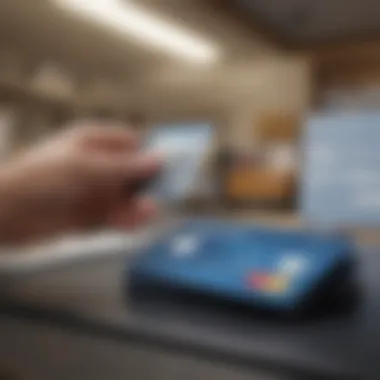Understanding the Capital One Secured Card Deposit Process


Intro
The Capital One Secured Card serves as a tool for individuals looking to build or improve their credit scores. Understanding the return deposit process is crucial. The deposit required for this secured card acts as collateral. Essentially, it ensures that Capital One has a safety net. Upon account closure or upgrade, the return of this deposit is a vital part of the process. This section will demystify how the return deposit works. It will also discuss conditions for eligibility and anything that may affect credit scores.
Market Overview
While the secured card market may not capture as much attention as other financial products, it plays a significant role. Consumers are increasingly turning to secured cards to build credit histories. With a growing emphasis on personal finance, the relevance of these products should not be overlooked.
Current Market Trends
The trend shows a rise in demand for secured credit cards. Many consumers find themselves seeking ways to establish credit histories. Recent statistics indicate a steady increase in applications for Capital One's secured card. This signifies a shift towards greater financial awareness.
Economic Indicators Impacting the Market
Economic factors heavily influence consumer behavior. Unemployment rates, inflation, and interest rates have a clear impact on credit applications. When the job market is stable, people feel more secure in applying for credit. Conversely, economic downturns may see increased interest in secured cards, as individuals prioritize rebuilding their credit.
Global Influences and Major Events
Global events can also affect the secured card landscape. Changes in regulations, such as the Credit Card Accountability Responsibility and Disclosure Act, shape how products are offered. Additionally, international economic trends can influence domestic consumer confidence. Understanding these factors is important for both consumers and financial institutions.
Eligibility Criteria for the Capital One Secured Card
Eligibility for the Capital One Secured Card is straightforward. Interested individuals must meet basic criteria. This includes being at least 18 years old and having a valid social security number. Importantly, a credit history is not strictly required, making it accessible. However, applicants should be aware that past bankruptcies may affect their chances.
The Return Deposit Process
Once approved, cardholders must make a deposit. This deposit typically ranges from $49 to $200. It works as an initial credit limit. Understanding the withdrawal process is essential when the time comes to close the account or upgrade.
Withdrawal Process
In general, if cardholders satisfy their obligations, the deposit is refundable. Upon account closure, Capital One reviews the account. This review involves checking the cardholder's payment history. If everything is in order, the deposit can be returned. Typically, the timeframe for returning the deposit ranges from 60 to 90 days.
Impact on Credit Scores
The Capital One Secured Card offers more than just a return deposit. Regular on-time payments can positively impact one's credit score. However, missed payments can result in negative marks. It is crucial to maintain vigilance to reap the benefits of using this financial tool.
Understanding how these elements intertwine provides clarity in personal finance management.
The End
The Capital One Secured Card is an effective instrument for building credit. However, cardholders must navigate the return deposit process wisely. By grasping the eligibility criteria, the withdrawal process, and potential impacts on credit scores, individuals can make informed decisions. This knowledge empowers consumers to take charge of their financial futures.
Preface to Secured Credit Cards
Secured credit cards represent a vital tool in personal finance management for individuals aiming to build or improve their credit scores. They serve as a bridge between those with limited credit history and the broader credit market. Typically, a secured credit card is linked to a cash deposit that functions as collateral, which significantly lowers the risk for issuers. This reduces the barriers for consumers and permits them to access credit in a more controlled manner.


Definition and Purpose
A secured credit card is a financial product designed for people who might struggle to qualify for an unsecured card due to a lack of credit history or past credit issues. Essentially, the cardholder makes an initial deposit, which usually becomes their credit limit. The primary purpose of a secured card is to provide an avenue for building or rebuilding credit. Through responsible usage, such as making timely payments and keeping balances low, individuals can enhance their creditworthiness. Secured credit cards can also be a stepping stone to obtaining an unsecured card in the future.
Overview of Capital One's Secured Card
Capital One's Secured Card is a notable option among secured credit offerings. It requires a minimum deposit but provides a competitive range of features. Users benefit from the opportunity to increase their credit limit over time by making consistent, responsible payments. Additionally, the Capital One Secured Card reports to all three major credit bureaus, which ensures that users' credit histories are accurately reflected as they manage their accounts. Overall, the Capital One Secured Card stands out due to its blend of accessibility and beneficial features for building credit.
Mechanics of the Capital One Secured Card
Understanding the mechanics of the Capital One Secured Card is crucial for those considering this financial product. This section elucidates how the secured card operates, focusing on the initial deposit requirements and the credit limit structure. Both elements are vital as they influence account usage and the potential impact on your credit profile.
Initial Deposit Requirements
To open a Capital One Secured Card account, a user must make an initial deposit. This deposit acts as a security measure for the lender, securing any credit extended to the cardholder. The amount of the deposit usually ranges from $49 to $200, reflecting the cardholder’s creditworthiness. An important detail is that your credit limit is typically equal to the amount of your deposit. For example, if you deposit $200, your credit limit will also be $200. Though it may seem restrictive, this framework encourages responsible credit use.
Moreover, the initial deposit serves as a benchmark for assessing the cardholder’s ability to handle credit. A solid deposit can help establish trust with the issuer, potentially leading to increases in credit limit over time.
Credit Limit Structure
The credit limit structure of the Capital One Secured Card directly correlates to the deposit made by the cardholder. Unlike unsecured credit cards, where credit limits are determined based on various factors such as income and credit history, the secured card's limit is relatively predictable.
- Deposit Equals Limit: Your credit limit equals your deposit amount, making it straightforward.
- Potential for Growth: After responsible usage and timely payments, you can request a higher limit, requiring additional deposits. This can enhance your credit score over time, aiding your financial journey.
- Maximizing Utilization: It is essential to use the card within the confines of the credit limit. Responsible utilization can lead not only to better credit scores but also to more favorable lending conditions in the future.
This structured approach helps cardholders learn about managing credit while minimizing risk for lenders. Understanding these mechanics is vital for individuals aiming to improve their credit score or build a financial foundation.
The Capital One Secured Card provides a valuable opportunity to build or rebuild your credit history, making these mechanics imperative to comprehend.
Return Deposit Process Explained
Understanding the return deposit process is vital for anyone using the Capital One Secured Card. The return deposit is not just a formality; it represents a significant financial decision for cardholders. Successfully navigating this process can impact personal finances, credit scores, and overall satisfaction with the secured card experience.
When and How Returns Occur
Returns of the security deposit typically occur when cardholders meet specific criteria set by Capital One. Usually, this process initiates when a cardholder closes their account or transitions to an unsecured card. Within this timeframe, the deposit will be assessed and processed. The important factor here is timing; the returns do not happen immediately. Proper closure and account standing is crucial. After a verified closure, expect a wait period that usually spans several weeks.
Key Points to Consider:
- Typically initiated upon closure of the account or upgrade
- Assessments take place after confirming account status
- Expected wait time ranges from several weeks
Eligibility for Deposit Return
Eligibility is a fundamental aspect when considering the return of your deposit. Generally, if the account has been in good standing, the deposit eligibility increases. Capital One outlines specific conditions that may affect this eligibility, including payment history and account balance at the time of closure. Additionally, customers who have maintained a satisfactory credit utilization ratio are often viewed more favorably during the return assessments.
Important Factors Include:
- Good standing with no missed payments
- Positive credit utilization ratio
- Confirmation of account closure or upgrade logs


Impact of Account Status on Returns
The current status of your Capital One Secured Card account directly influences the return of your deposit. For instance, if there are outstanding balances or unpaid fees, the return may be delayed or even denied. In contrast, an account that demonstrates punctual payments and responsible management may see faster processing of the return.
Special Considerations:
- Negative marks on account history could prevent deposits from being returned
- Tracking your account status can help anticipate any issues
- Communicate proactively with customer service if there are delays
Maintaining a positive account status is crucial for an effortless return of your security deposit.
Navigating the Capital One Secured Card return deposit process requires attention to detail and knowledge of eligibility criteria. Understanding the importance of these elements can empower cardholders to make informed decisions that align with their financial goals.
Steps to Initiate a Return Deposit
Initiating a return deposit on the Capital One Secured Card is an important step for cardholders who want to reclaim their security deposits after successfully transitioning to more flexible credit options. Understanding how to initiate this process can help avoid confusion and ensure a smooth transaction.
Contacting Customer Service
The first step in initiating a return deposit is to reach out to Capital One's customer service. This interaction is crucial, as it allows cardholders to express their intention and gather necessary information. Customers can contact Capital One through various channels, including phone, online chat, or the mobile app.
It is advisable to have a few key pieces of information handy when contacting customer service. These include your account number, personal information for verification, and any relevant details regarding your secured card status. Being well-prepared can expedite the process.
Documenting Your Request
Once you have spoken with customer service, the next step involves documenting your request. This measure is essential for maintaining a clear record of your interaction. It is wise to note down the name of the representative, the time of the call, and the requested actions.
Additionally, if instructed to submit a written request, it is important to include details such as your account number, the nature of your request, and your contact information. Sending this request via certified mail can further ensure that it is received and processed accordingly.
Expected Timeframe for Processing
The timeframe for processing a return deposit can vary. Generally, customers may expect to receive their deposits back within a certain period after initiating their request. Factors such as account status and any existing balances may affect this duration.
Most cardholders report that the return deposit is processed within 4 to 6 weeks, but it can take longer depending on the circumstances. Keeping track of your request’s progress through customer service can help manage expectations during this waiting period.
Always ensure to follow up if you do not see any updates within the expected timeframe. Persistently communicating your concerns can often lead to resolution.
In summary, understanding the steps to initiate a return deposit is vital for cardholders looking to regain their secured funds. By contacting customer service, documenting requests, and being aware of the expected processing timeframe, users can navigate this process effectively.
Understanding the Financial Implications
Understanding the financial implications of the Capital One Secured Card is crucial for cardholders. It involves recognizing how a secured card can impact both short-term finances and long-term credit health. This section will address two main aspects: the effect on credit scores and the reallocation of secured funds.
Effect on Credit Score
Using a secured card like the Capital One Secured Card can significantly influence your credit score. When you issue your initial deposit, it acts as a security for the credit limit. Each time you use your card and pay the bill on time, it can positively impact your credit history.


A few key factors about credit scores to consider include:
- Payment History: This aspect is a primary component of your credit score. Regular on-time payments can improve your score over time.
- Credit Utilization Ratio: Maintaining a low balance relative to your limit can signal responsible credit use.
- Length of Credit History: Having a longer history with the card can benefit your overall score.
However, it is essential to keep in mind that missing late payments or accumulating high balances can harm your credit score. Each month’s activity is typically reported to credit bureaus, which means it's vital to manage your usage carefully.
Maintaining good financial habits with the Capital One Secured Card can lead to higher credit scores, as long as you honor your payment commitments.
Reallocation of Secured Funds
The impact of the return deposit is another vital point to understand. Once you have built a track record of responsible credit use, you may become eligible for the return of your security deposit. This means that the funds will be accessible, and you can consider reallocating them to other financial needs.
When your deposit is returned, there are specific options for using the funds:
- Reinvesting: You may choose to invest the returned deposit into stocks or bonds.
- Paying Down Debts: Applying the funds toward outstanding debts can reduce overall financial liability.
- Emergency Savings: Keeping this money in a savings account for unforeseen expenses can be wise.
Understanding how the return deposit can affect your financial strategies enables you to make informed decisions about your overall financial health. The return of your deposit reflects your ability to manage credit responsibly and serves as a stepping stone towards better credit products.
Alternatives to the Capital One Secured Card
Understanding the alternatives to the Capital One Secured Card helps consumers make informed decisions for their credit needs. It is important to explore other options when choosing a secured credit card or even considering unsecured alternatives. Each alternative may offer distinct benefits tailored to different financial situations.
Other Secured Cards on the Market
Various secured credit cards provide comparable features to the Capital One Secured Card. Here’s a look at some notable options:
- Discover it® Secured: This card offers cash back on purchases, making it unique among secured cards. New users can also benefit from a dollar-for-dollar match on cash back earned during the first year.
- OpenSky® Secured Visa® Credit Card: This card does not require a credit check for approval, making it accessible for individuals with poor credit. Additionally, it reports to all three major credit bureaus, helping you build credit over time.
- Citi® Secured Mastercard®: Another strong option, this card requires a minimum deposit but also rewards responsible credit use by reporting to credit bureaus.
These alternatives demonstrate that the market is filled with potential secured credit card choices, each with its own appeal. When selecting a secured credit card, consider features like annual fees, interest rates, and rewards.
Unsecured Credit Options
Transitioning from a secured card to an unsecured credit card can be a sound strategy for individuals looking to build their credit further. Unsecured cards typically do not require a deposit, making them more convenient once eligibility is achieved. Some options worth considering include:
- Capital One Platinum Credit Card: Designed for users with average credit, it offers a path to transition to an unsecured card without needing a deposit.
- Discover it® Cashback Credit Card: It features cash back rewards, encouraging responsible credit usage while offering an attractive rewards program for those with good credit.
- Chase Freedom Unlimited®: This card provides an introductory offer along with cash back on all purchases, appealing to individuals who manage credit responsibly.
Choosing between alternatives depends largely on personal financial circumstances and objectives. Secured options may provide a good starting point for those new to credit or rebuilding their scores. These factors compel consumers to weigh the potential benefits of each card against their own financial goals.
Ending
Understanding the intricacies of the Capital One Secured Card return deposit process is essential for anyone considering this financial product. This section serves to encapsulate the critical elements discussed throughout the article, highlighting its significance and the practical benefits it offers to cardholders.
The return deposit is not just a procedural formality; it represents a financial commitment that deeply influences credit behaviors. By discerning how and when deposits can be returned, individuals position themselves better for future credit opportunities. The timing of the return, alongside the eligibility criteria, elucidates the pathway toward regaining secured funds. This, in turn, has implications for one's overall financial strategy and credit management.
Summarizing the Importance of Understanding Deposits
Understanding deposits in the context of the Capital One Secured Card encompasses several critical points:
- Financial Literacy: Grasping the nuances of your secured deposit deepens your knowledge of how credit cards operate within financial ecosystems.
- Strategic Planning: The knowledge of when and how you may receive your security deposit back allows for better financial decision-making.
- Credit Score Impact: Recognizing the role of secured credit in building or maintaining a good credit score cannot be overstated. A careful approach to credit management can yield better scores over time.
- Eligibility Awareness: Being well-informed about the factors affecting your eligibility for a return deposit helps avoid misunderstandings that could lead to delays.
- You can prepare for future expenses or manage other debts more effectively.
As we revisit the importance of understanding deposits, it becomes clear that knowledge empowers individuals in their financial journey. With insights gained from this article, investors, finance enthusiasts, and professional traders can navigate the complexities of secured credit cards with confidence.



